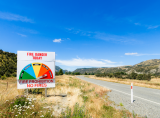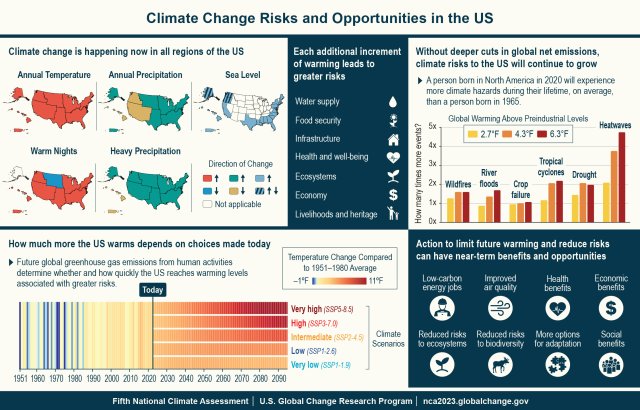Frequently Asked Questions About Climate Change
This page includes answers to some frequently asked questions about climate change. For information about evidence of climate change, the greenhouse effect, and the human role in climate change, please see EPA Climate Science.
- Terms
- Today’s Climate Change
- Is there scientific consensus that human activities are causing today’s climate change?
- Do natural variations in climate contribute to today’s climate change?
- Is climate change happening in the same way everywhere on the planet?
- Why has my town experienced record-breaking cold and snowfall if the climate is warming?
- Impacts
- Solutions
Terms
What is climate change?

Climate change involves significant changes in average conditions—such as temperature, precipitation, wind patterns, and other aspects of climate—that occur over years, decades, centuries, or longer. Climate change involves longer-term trends, such as shifts toward warmer, wetter, or drier conditions. These trends can be caused by natural variability in climate over time, as well as human activities that add greenhouse gases to the atmosphere like burning fossil fuels for energy.
What is the difference between weather and climate?
"Weather" refers to the day-to-day state of the atmosphere such as the combination of temperature, humidity, rainfall, wind, and other factors. "Climate" describes the weather of a place averaged over a period of time, often 30 years or more.
The difference between weather and climate is largely defined by time and geography. Weather refers to the conditions of the atmosphere over a short period of time and typically for a local area. Climate refers to the behavior of the atmosphere over a longer period of time, and usually for a large area. Scientists can compare recent and long-term observations of the climate to detect the influence of greenhouse gases on climate conditions.
What is the difference between global warming and climate change?
The terms "global warming" and "climate change" are sometimes used interchangeably, but global warming is just one of the ways in which climate is affected by rising concentrations of greenhouse gases. "Global warming" describes the recent rise in the global average temperature near the earth's surface, which is caused mostly by increasing concentrations of greenhouse gases (such as carbon dioxide and methane) in the atmosphere from human activities such as burning fossil fuels for energy.
What is the difference between climate change and climate variability?
Climate change occurs over a long period of time, typically over decades or longer. In contrast, climate variability includes changes that occur within shorter timeframes, such as a month, season, or year. Climate variability explains the natural variability within the system. For example, one unusually cold or wet year followed by an unusually warm or dry year would not be considered a sign of climate change.
Today’s Climate Change
Is there scientific consensus that human activities are causing today’s climate change?
Yes. Climate scientists overwhelmingly agree that human activities are responsible for today’s climate change, primarily by releasing excess greenhouse gases into the atmosphere. These greenhouse gas emissions come from activities such as burning fossil fuels for energy, raising livestock, and clearing forests. The Intergovernmental Panel on Climate Change's (IPCC) Sixth Assessment Report, which represents the work of hundreds of leading experts in climate science, states that "it is unequivocal that human influence has warmed the atmosphere, ocean and land. Widespread and rapid changes in the atmosphere, ocean, cryosphere, and biosphere have occurred."1
The Fifth National Climate Assessment, developed by the U.S. Global Change Research Program—which is composed of 15 federal scientific agencies—concluded that scientific evidence consistently points to human activities, rather than natural climate trends, as the “only credible explanation” for the average temperature increase of nearly 2°F since the late 1800s.2
“Human activities have unequivocally caused the global warming observed over the industrial era, altering the intensity, frequency, and duration of many weather and climate extremes, including extreme heat, extreme precipitation and flooding, drought, and wildfire.”
Fifth National Climate Assessment, Chapter 3. Earth Systems Processes 3
Hundreds of independent and governmental scientific organizations have released similar statements, both in the United States and worldwide, including the World Meteorological Organization, the American Meteorological Society, and the American Geophysical Union.

Do natural variations in climate contribute to today’s climate change?
The earth does go through natural cycles of warming and cooling caused by factors such as changes in the sun or volcanic activity. For example, there were times in the distant past when the earth was warmer than it is now. However, natural variations in climate do not explain today’s climate change. Most of the warming since 1950 has been caused by human emissions of greenhouse gases that come from a variety of activities, including burning fossil fuels.
Is climate change happening in the same way everywhere on the planet?
Although climate change is often referred to in global terms, different geographic regions are experiencing climate change in different ways. For example, some places, like the Arctic, are experiencing warming more rapidly than the rest of the world.4
Differences such as these are related to natural climate variations, which can occur because of differences in factors such as topography, ocean currents, and latitude. Differences in land use can also affect regional changes in climate. For example, urbanization and deforestation have both shown to exacerbate increasing temperatures.5
Why has my town experienced record-breaking cold and snowfall if the climate is warming?
Even though the planet is experiencing an overall average warming, some areas may be experiencing extra cold or snowy winters. These cold spells are due to variability in local weather patterns, which sometimes lead to colder-than-average seasons or even colder-than-average years at the local or regional level. In fact, a warmer climate allows for more water vapor in the air, which may lead to extra snowy winters in some areas. As long as it is still cold enough to snow, a warming climate can lead to bigger snowstorms.
Impacts
Why be concerned about a degree or two change in the average global temperature?

The global average temperature has increased about 1.7°F since 1970. During this same period, temperatures have risen around 2.5°F in the contiguous United States and 4.2°F in Alaska.6 Globally, 2023 was the warmest year on record. The period 2014–2023 was the warmest decade on record since thermometer-based observations began.7
A degree or two change in average global temperature might not sound like much to worry about, but relatively small changes in the earth’s average temperature can mean big changes in local and regional climate, creating risks to public health and safety, water resources, agriculture, infrastructure, and ecosystems.
Among the many examples of changes cited by the Fifth National Climate Assessment are:
- An increase in heat waves and days with temperatures above 90°F
- More extreme weather events such as storms, droughts, and floods
- An increase in wildfires and longer wildfire seasons
- A projected sea level rise of 1 to 4 feet by the end of this century, which could put certain areas of the country underwater
- Melting sea ice and thawing permafrost in the Arctic
- An increase in heat stress on ecosystems, agriculture, and livestock, resulting in biodiversity loss, habitat shifts, and food supply disruptions
- Power grid strain through increased electrical demand for cooling
- Infrastructure damage such as buckling bridges, roads, and railways
How does climate change affect people’s health?
Climate change poses many threats to people’s health and well-being. Among the health impacts cited by the Fifth National Climate Assessment are the following:
- Atmospheric warming has the potential to increase ground-level ozone in many regions, which can cause multiple health issues (e.g., bronchitis, emphysema, and asthma) and worsen lung function.
- Higher summer temperatures are linked to an increased risk of heat-related illnesses and death. Older adults, pregnant women, and children are at particular risk, as are people living in urban areas because of the additional heat associated with urban heat islands.
- Climate change is expected to expand the range and activity of ticks that carry Lyme disease or other bacterial and viral agents, as well as mosquitoes that transmit West Nile and other viruses, which can increase exposure for more people.
- More frequent extreme weather events such as droughts, hurricanes, floods, and wildfires will not only put people’s lives at risk, but can also worsen underlying medical conditions, increase stress, and lead to adverse mental health effects.
- Rising temperatures and extreme weather have the potential to disrupt the availability, safety, and nutritional quality of food.
See EPA’s Climate Indicators website for more information about the effects of climate change in the United States.
Who is most at risk from the impacts of climate change?
Everyone will be affected by climate change, but some people may be more affected than others. Among the most vulnerable people are those in overburdened, underserved, and economically distressed communities. Three key factors influence a person’s vulnerability to the impacts of climate change:
- Exposure. Some people are more at risk simply because they are more exposed to climate change hazards where they live or work. For example, people who live on the coast can be more vulnerable to sea level rise, coastal storms, and flooding.
- Sensitivity. Some people are more sensitive to the impacts of climate change, such as children, pregnant women, and those with pre-existing medical conditions such as asthma.
- Adaptability. Older adults, those with disabilities, those with low income, and some Indigenous people may have more difficulty than others in adapting to climate change hazards.
In addition, there is a wide range of other factors that influence people’s vulnerability. For example, people with less access to healthcare, adequate housing, and financial resources are less likely to rebound from climate disasters. People who are excluded from planning processes, experience racial and ethnic discrimination, or have language barriers are also more vulnerable to and less able to prepare for and avoid the risks of climate change.
Learn more about the connections between climate change and human health.
Solutions
How can people reduce the risks of climate change?
Reducing risk involves both mitigation and adaptation.
- Climate change mitigation refers to actions limiting the magnitude and rate of future climate change by reducing greenhouse gas emissions and/or advancing nature-based solutions.
- Climate change adaptation or climate adaptation means taking action to prepare for and adjust to both the current and projected impacts of climate change.
People can reduce the risks of climate change by making choices that reduce greenhouse gas emissions and by preparing for the changes expected in the future. Decisions that people make today will shape the world for decades and even centuries to come. Communities can also prepare for the changes in the decades ahead by identifying and reducing their vulnerabilities and considering climate change risks in planning and development. Such actions can ensure that the most vulnerable populations—such as young children, older adults, and people living in poverty—are protected from the health and safety threats of climate change.
What are the benefits of taking action now?

The longer people wait to act on climate change, the more damaging its effects will become on the planet and people’s health. If people fail to take action soon, more drastic and costly measures to prevent greenhouse gases from exceeding dangerous levels could be needed later. The Fifth National Climate Assessment found that global efforts to reduce greenhouse gas emissions could avoid tens of thousands of deaths per year in the United States by the end of the century, as well as billions of dollars in damages related to water shortages, wildfires, agricultural losses, flooding, and other impacts.
“With each additional increment of warming, the consequences of climate change increase. The faster and further the world cuts greenhouse gas emissions, the more future warming will be avoided, increasing the chances of limiting or avoiding harmful impacts to current and future generations.”
Fifth National Climate Assessment, Overview 8
There are many actions that people can take now to help reduce the risk of climate change while also improving the natural environment, community infrastructure and transportation systems, and overall health.

Climate change presents many risks across the country. Action to limit warming and reduce risks creates benefits and opportunities for the United States. Source: U.S. Global Change Research Program, Fifth National Climate Assessment, Chapter 1: Overview, 2023.
References
1 IPCC, 2021: Summary for Policymakers. In: Climate Change 2021: The Physical Science Basis. Contribution of Working Group I to the Sixth Assessment Report of the Intergovernmental Panel on Climate Change [Masson-Delmotte, V., P. Zhai, A. Pirani, S.L. Connors, C. Péan, S. Berger, N. Caud, Y. Chen, L. Goldfarb, M.I. Gomis, M. Huang, K. Leitzell, E. Lonnoy, J.B.R. Matthews, T.K. Maycock, T. Waterfield, O. Yelekçi, R. Yu, and B. Zhou (eds.)]. https://www.ipcc.ch/report/ar6/wg1/downloads/report/IPCC_AR6_WGI_SPM.pdf (pdf) p. 4
2 Marvel, K., W. Su, R. Delgado, S. Aarons, A. Chatterjee, M.E. Garcia, Z. Hausfather, K. Hayhoe, D.A. Hence, E.B. Jewett, A. Robel, D. Singh, A. Tripati, and R.S. Vose, 2023: Ch. 2. Climate trends. In: Fifth National Climate Assessment. Crimmins, A.R., C.W. Avery, D.R. Easterling, K.E. Kunkel, B.C. Stewart, and T.K. Maycock, Eds. U.S. Global Change Research Program, Washington, DC, USA. https://doi.org/10.7930/NCA5.2023.CH2, p. 2-4.
3 Leung, L.R., A. Terando, R. Joseph, G. Tselioudis, L.M. Bruhwiler, B. Cook, C. Deser, A. Hall, B.D. Hamlington, A. Hoell, F.M. Hoffman, S. Klein, V. Naik, A.G. Pendergrass, C. Tebaldi, P.A. Ullrich, and M.F. Wehner, 2023: Ch. 3. Earth systems processes. In: Fifth National Climate Assessment. Crimmins, A.R., C.W. Avery, D.R. Easterling, K.E. Kunkel, B.C. Stewart, and T.K. Maycock, Eds. U.S. Global Change Research Program, Washington, DC, USA. https://doi.org/10.7930/NCA5.2023.CH3
4 Constable et al. (2022). Cross-Chapter Paper 6: Polar Regions. In: Climate Change 2022: Impacts, Adaptation and Vulnerability. Contribution of Working Group II to the Sixth Assessment Report of the Intergovernmental Panel on Climate Change [H.-O. Pörtner, D.C. Roberts, M. Tignor, E.S. Poloczanska, K. Mintenbeck, A. Alegría, M. Craig, S. Langsdorf, S. Löschke, V. Möller, A. Okem, B. Rama (eds.)]. Cambridge University Press, Cambridge, UK and New York, NY, USA, pp. 2319–2368, doi:10.1017/9781009325844.023.
5 IPCC. (2019). Summary for Policymakers. In: Climate Change and Land: an IPCC special report on climate change, desertification, land degradation, sustainable land management, food security, and greenhouse gas fluxes in terrestrial ecosystems [P.R. Shukla, J. Skea, E. Calvo Buendia, V. Masson-Delmotte, H.- O. Pörtner, D. C. Roberts, P. Zhai, R. Slade, S. Connors, R. van Diemen, M. Ferrat, E. Haughey, S. Luz, S. Neogi, M. Pathak, J. Petzold, J. Portugal Pereira, P. Vyas, E. Huntley, K. Kissick, M. Belkacemi, J. Malley, (eds.)].
6 Marvel, K., W. Su, R. Delgado, S. Aarons, A. Chatterjee, M.E. Garcia, Z. Hausfather, K. Hayhoe, D.A. Hence, E.B. Jewett, A. Robel, D. Singh, A. Tripati, and R.S. Vose, 2023: Ch. 2. Climate trends. In: Fifth National Climate Assessment. Crimmins, A.R., C.W. Avery, D.R. Easterling, K.E. Kunkel, B.C. Stewart, and T.K. Maycock, Eds. U.S. Global Change Research Program, Washington, DC, USA. https://doi.org/10.7930/NCA5.2023.CH2, p. 2-11.
7 EPA (2024). Climate Change Indicators: U.S. and Global Temperature. Accessed November 20, 2024 https://www.epa.gov/climate-indicators/climate-change-indicators-us-and-global-temperature
8 Jay, A.K., A.R. Crimmins, C.W. Avery, T.A. Dahl, R.S. Dodder, B.D. Hamlington, A. Lustig, K. Marvel, P.A. Méndez-Lazaro, M.S. Osler, A. Terando, E.S. Weeks, and A. Zycherman, 2023: Ch. 1. Overview: Understanding risks, impacts, and responses. In: Fifth National Climate Assessment. Crimmins, A.R., C.W. Avery, D.R. Easterling, K.E. Kunkel, B.C. Stewart, and T.K. Maycock, Eds. U.S. Global Change Research Program, Washington, DC, USA. https://doi.org/10.7930/NCA5.2023.CH1, p. 1-37.
